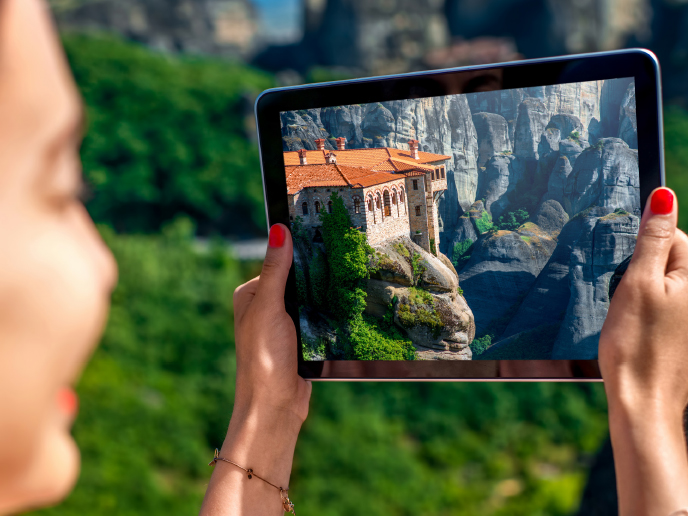How digital technologies can play a vital role for the preservation of Europe’s cultural heritage
Whether it’s a priceless Dutch Golden Age painting, a ruined Roman Forum surrounded by olive groves on a sleepy Mediterranean hillside or a more modern audiovisual masterpiece of the 20th century, our cultural heritage can be both easily and permanently damaged or, in the worst-case scenario, even destroyed. The numerous natural or human-derived threats to our cultural heritage range from pollution, flooding and wind erosion, through to vandalism and improper maintenance and/or care. The digitisation of cultural heritage is important for the protection, conservation, restoration, research, dissemination and promotion of tangible and intangible cultural assets, coming from all types of cultural institutions (museums, galleries, libraries and archives, monuments and sites). The possibilities opened up by the increasing advances in digital technologies are impressive and ever-growing. From 3D tech, to artificial intelligence and virtual/augmented reality, these are all being used to not only ensure preservation but also capture the imaginations of younger, digital-native Europeans inspiring the admiration and appreciation for Europe’s vast cultural treasures. Concepts such as the Virtual Museum are being eagerly adopted, fuelled by the notion that if one cannot physically get to the museum, then the museum can come to them – only possible through the explosion of digital innovations over the last 20 years.
How EU policy helps to digitally promote and preserve cultural artefacts
The European Commission through extensive policy, coordination and funding actions supports Member States’ cultural policy, with a special emphasis on digitisation and online access to cultural material and digital preservation and curation. Europeana, Europe’s platform for digital cultural heritage, works with thousands of archives, libraries and museums across Europe to make cultural content easy to access, use and reuse. It is the only pan-European platform of its kind and plays a key role in making our cultural heritage community stronger. Alongside these efforts, in 2019, 26 European countries signed a Declaration of cooperation on advancing digitisation of cultural heritage. The Declaration invites Member States to leverage synergies between digital technologies and Europe’s cultural heritage in three key areas: (i) a pan-European initiative for 3D digitisation of cultural heritage artefacts, monuments and sites; (ii) enhancing cross-sector, cross-border cooperation and capacity building in the digital cultural heritage sector; and (iii) fostering citizen engagement, innovative use and spillovers in other sectors. In 2020, with the help of experts, the Commission also finalised the 10 basic principles for 3D digitisation of tangible cultural heritage, an important guideline for heritage professionals wanting to digitise their content. And of course, COVID-19 has clearly highlighted the need to improve online access to cultural heritage – indeed, whilst many European cultural institutions had to close, many have since bounced back by expanding their digital offerings. Through the Horizon 2020 programme, the Commission offers prominent and ongoing support to research and innovation in the cultural heritage domain, with special emphasis on the use of cutting-edge technologies. From 2014-2020, funds through Horizon 2020 towards digital cultural heritage have been around EUR 70 million in total and funding for these initiatives will likely continue with the launch of the next research and innovation programme, Horizon Europe.
Proudly exhibiting our projects
In total, this CORDIS Results Pack features 16 projects (12 from the original Pack published in 2020 and four new projects added in 2021) that are making important contributions to digital cultural heritage efforts. In particular, the ARCHES, DigiArt and EU-LAC-MUSEUMS projects have been harnessing technologies such as 3D modelling and augmented reality, as well as more comprehensive international cooperation, to increase the accessibility and enjoyment of museums as a key institution of cultural curation and preservation. Other projects have focused on using technology to increase social awareness and interest in cultural heritage and preservation. For example, PLUGGY developed the first-ever social network dedicated to promoting European cultural heritage, whilst the I-Media-Cities project has launched a revolutionary platform that uses audiovisual material to allow anyone to discover the rich cultural heritage of nine European cities. Meanwhile, the EMOTIVE project tapped into the raw power of storytelling by offering tools to heritage professionals that allow them to create interactive storytelling experiences that engage, inform and provoke the interest of audiences. Finally, the ArchAIDE project developed innovative software to identify fragments of pottery found during excavations and to store them in a dedicated database, thus helping the vital work of archaeologists and other professionals in the cultural heritage field, whilst Time Machine has been developing large-scale digitisation and computing infrastructure using AI and Big Data mining in order to extract and analyse the vast amount of data generated when digitising archives from museums and libraries. Of the four new projects that have been added in 2021, the NewsEye project has developed new tools to help better preserve newspapers and allow for easier search options when using historical newspapers for historical research. In a similar vein, TROMPA has pioneered its own digital tools to enrich and democratise publicly available classical music heritage through a user-centred co-creation set-up. Technology created by the V4Design project will allow architects and video game designers to integrate existing digital content into their designs in stunning 3D. Finally, SILKNOW took on the challenge to help preserve a vital part of our textile heritage, specifically silk. This updated CORDIS Results Pack is dedicated to the memory of Ellen Schraudolph-Gautier, whose passion was to drive the field of cultural heritage forward and to ensure that all of these research projects were a resounding success.



